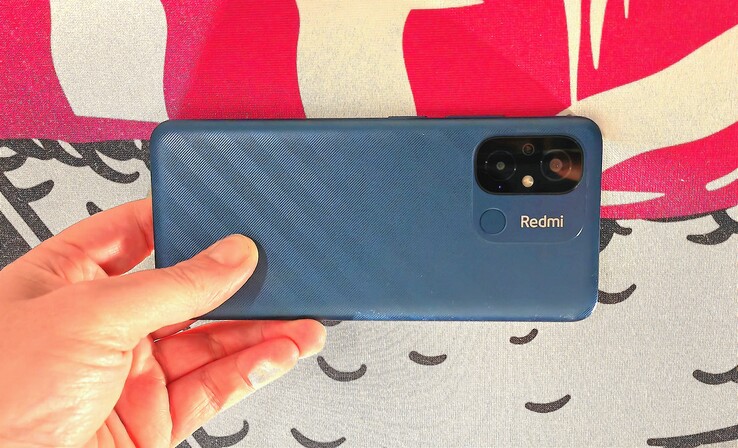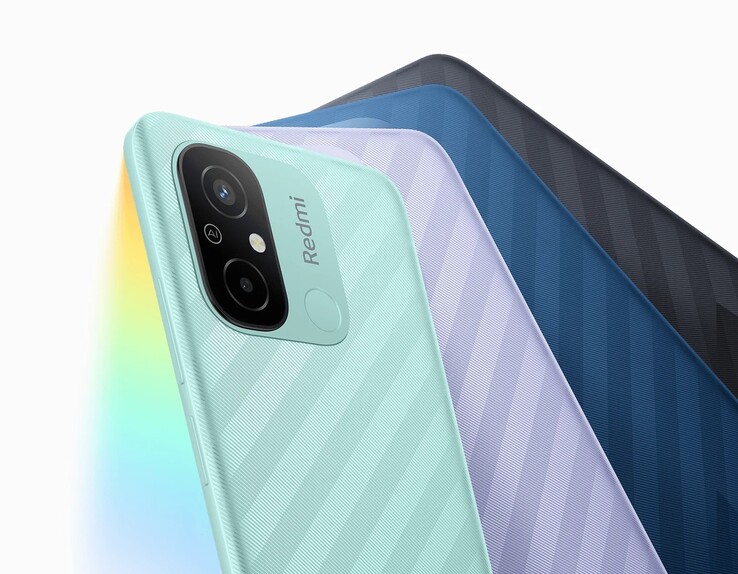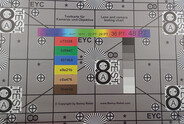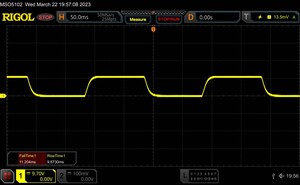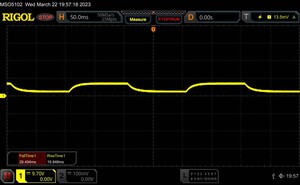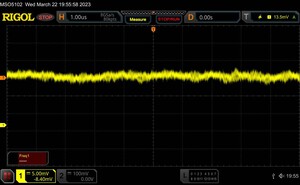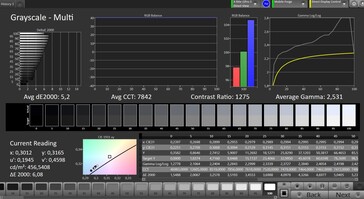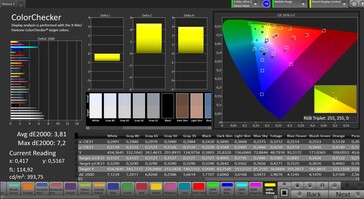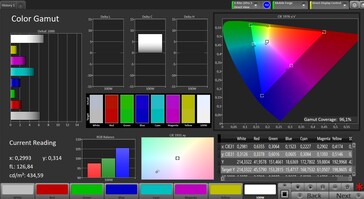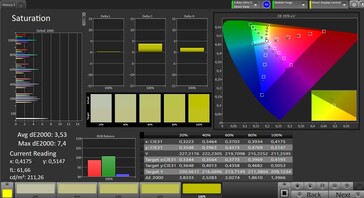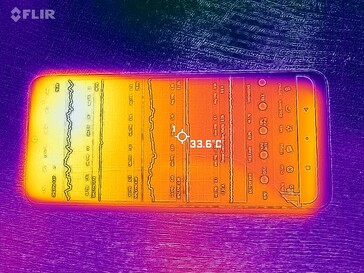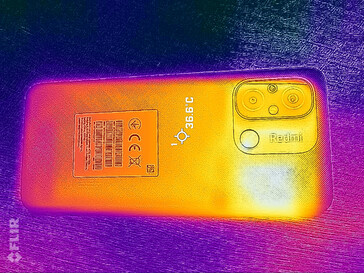Xiaomi Redmi 12C Smartphone review - Fast, but outdated in some respects
Possible competitors in comparison
Rating | Date | Model | Weight | Drive | Size | Resolution | Price |
|---|---|---|---|---|---|---|---|
| 76.6 % v7 (old) | 04 / 2023 | Xiaomi Redmi 12C Helio G85, Mali-G52 MP2 | 192 g | 128 GB eMMC Flash | 6.71" | 1650x720 | |
| 77.3 % v7 (old) | 11 / 2022 | Samsung Galaxy A13 4G A137F Helio G80, Mali-G52 MP2 | 195 g | 64 GB eMMC Flash | 6.60" | 2408x1080 | |
| 78.9 % v7 (old) | 11 / 2022 | Xiaomi Poco M5 Helio G99, Mali-G57 MP2 | 201 g | 128 GB UFS 2.2 Flash | 6.58" | 2408x1080 | |
| 76.6 % v7 (old) | 07 / 2022 | Xiaomi Redmi 10C SD 680, Adreno 610 | 190 g | 64 GB UFS 2.2 Flash | 6.71" | 1650x720 | |
| 79 % v7 (old) | 04 / 2023 | Motorola Moto G13 Helio G85, Mali-G52 MP2 | 183.5 g | 128 GB eMMC Flash | 6.50" | 1600x720 |
Case and equipment - Outdated USB port
Xiaomi's Redmi 12C is an inexpensive smartphone that can be purchased for well under 200 Euros (~$200), depending on the storage configuration.
Xiaomi offers four color options: dark gray, purple, mint green, and blue. The back is made of plastic and has a palpable stripe pattern, like the predecessor Redmi 10C. The camera module is still very bulky, but it has now been partially adapted to the back in terms of color to look more discreet.
The casing's stability is okay, but quiet creaking noises can be heard when twisting. The screen's edges are also a bit sharp.
Three different storage configurations can be found on Xiaomi's website:
- 3 GB RAM / 32 GB mass storage: 150 Euro
- 3 GB RAM / 64 GB mass storage: 170 Euro (~$570)
- 4 GB RAM / 128 GB mass storage: 200 Euro
Thanks to promotional coupons, however, you can get the smartphone cheaper, and the Redmi 12C is also sold with a significant discount on the rest of the Internet.
We do not understand how Xiaomi can install a microUSB port in the Redmi 12C in 2023. We thought that the time of the confusing variety of ports would finally be over, especially since even the Redmi 10C already had a USB-C port.
The microSD card reader can be used in addition to 2 nano-SIMs, though it is not the fastest in the tests with our reference card Angelbird V60.
| SD Card Reader - average JPG Copy Test (av. of 3 runs) | |
| Xiaomi Redmi 10C (Angelbird V60) | |
| Average of class Smartphone (5.72 - 58.9, n=68, last 2 years) | |
| Samsung Galaxy A13 4G A137F (Angelbird V60) | |
| Motorola Moto G13 (Angelbird V60) | |
| Xiaomi Poco M5 (Angelbird V60) | |
| Xiaomi Redmi 12C (Angelbird V60) | |
Cross Platform Disk Test (CPDT)
Communication, software and operation - Update promise for the software
The WiFi 5 module in the Redmi 12C does a slightly better job than in the predecessor, but it cannot quite keep up with other devices in the price range in terms of receiving speed. This is mainly due to a short drop in the transfer rate, which we can observe again and again at different points even when repeating the test.
The Xiaomi Phone can use 4G as the fastest mobile network and comes with the necessary frequencies for Central Europe. For further trips, you should check in advance which LTE bands you need in the host country and whether the Redmi 12C supports them. The reception quality in the mobile network is decent but cannot keep up with high-end phones.
The software is called MiUI 13, but it is still based on Android 12. The good update promise of 2 Android versions that Xiaomi makes for this phone therefore only extends to Android 14. At least the security patches are renewed quite regularly: every 3 months; they were from March 2023 on our device, which is fairly up-to-date at the time of testing.
The fingerprint sensor is integrated into the camera module on the back. It unlocks the smartphone quite reliably after a short wait. Face recognition is also possible, but it is software-based and thus not as secure.
| Networking | |
| iperf3 transmit AXE11000 | |
| Xiaomi Poco M5 | |
| Motorola Moto G13 | |
| Samsung Galaxy A13 4G A137F | |
| Xiaomi Redmi 12C | |
| Xiaomi Redmi 10C | |
| iperf3 receive AXE11000 | |
| Xiaomi Poco M5 | |
| Motorola Moto G13 | |
| Samsung Galaxy A13 4G A137F | |
| Xiaomi Redmi 12C | |
| Xiaomi Redmi 10C | |
Cameras - The standard sensor of the price range
Like numerous other inexpensive phones, the Redmi 12C uses Samsung's Isocell JN1 as the main camera's image sensor. The additional camera now only has a 0.1-megapixel lens, but it cannot be used to create photos anyway and only provides additional data for portrait mode.
Main camera takes partly blurry pictures, and the brightness also leaves a lot to be desired. This is not only noticed in daylight but also dark lighting conditions and strong contrasts. Bright areas are over-brightened, while dark ones hardly show any pattern in the photo. The camera is also a bit blurry in full studio lighting in the lab, but the contrasts are acceptable here.
The selfie camera is located in a waterdrop notch at the top of the screen. It has a resolution of 5 megapixels. The resulting photos look quite bright at first glance, but they do not show any drawing, especially in dark areas, and the details are rather poor when enlarged.
Overall, the cameras of the Redmi 12C are on par with the competition.
Image comparison
Choose a scene and navigate within the first image. One click changes the position on touchscreens. One click on the zoomed-in image opens the original in a new window. The first image shows the scaled photograph of the test device.
Main cameraMain cameraLowLight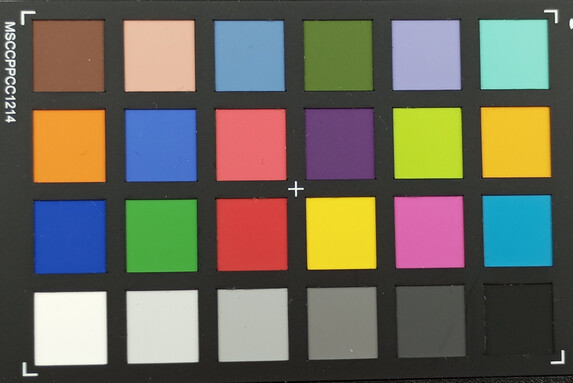
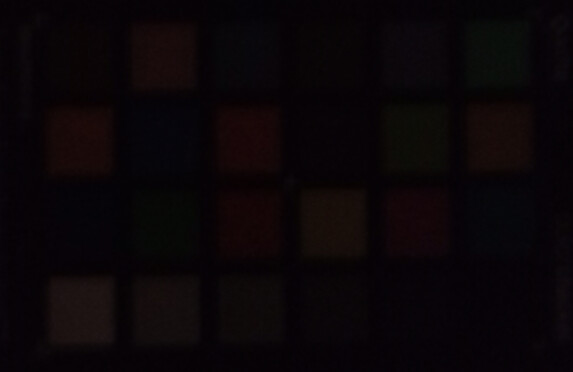
Display - More brightness and pixels would have been nice
Xiaomi would have had a chance to stand out with the screen: Full HD screens are definitely possible in this price range, like the Galaxy A13 4G or the Poco M5, or very bright screens like in the Moto G13.
However, the manufacturer does without that and installs a 720p screen with a brightness that is even below 400 cd/m² on average in our tests. Thus it is often difficult to see anything on the screen outdoors or in bright rooms.
We did not notice PWM, but a visible color cast into purple in the grayscale. Overall, the screen's color accuracy is okay.
| |||||||||||||||||||||||||
Brightness Distribution: 85 %
Center on Battery: 417 cd/m²
Contrast: 1191:1 (Black: 0.35 cd/m²)
ΔE ColorChecker Calman: 3.81 | ∀{0.5-29.43 Ø4.77}
ΔE Greyscale Calman: 5.2 | ∀{0.09-98 Ø5}
96.1% sRGB (Calman 2D)
Gamma: 2.531
CCT: 7842 K
| Xiaomi Redmi 12C IPS, 1650x720, 6.7" | Samsung Galaxy A13 4G A137F PLS, 2408x1080, 6.6" | Xiaomi Poco M5 IPS, 2408x1080, 6.6" | Xiaomi Redmi 10C IPS, 1650x720, 6.7" | Motorola Moto G13 IPS, 1600x720, 6.5" | |
|---|---|---|---|---|---|
| Response Times | -19% | 19% | 17% | -30% | |
| Response Time Grey 50% / Grey 80% * (ms) | 49.5 ? | 39 ? 21% | 33 ? 33% | 33 ? 33% | 48.5 ? 2% |
| Response Time Black / White * (ms) | 20.9 ? | 33 ? -58% | 20 ? 4% | 21 ? -0% | 33.8 ? -62% |
| PWM Frequency (Hz) | |||||
| Screen | 7% | 33% | 24% | 11% | |
| Brightness middle (cd/m²) | 417 | 492 18% | 400 -4% | 511 23% | 555 33% |
| Brightness (cd/m²) | 397 | 453 14% | 396 0% | 478 20% | 553 39% |
| Brightness Distribution (%) | 85 | 87 2% | 96 13% | 84 -1% | 93 9% |
| Black Level * (cd/m²) | 0.35 | 0.37 -6% | 0.27 23% | 0.42 -20% | 0.29 17% |
| Contrast (:1) | 1191 | 1330 12% | 1481 24% | 1217 2% | 1914 61% |
| Colorchecker dE 2000 * | 3.81 | 4.34 -14% | 1.26 67% | 1.51 60% | 5.17 -36% |
| Colorchecker dE 2000 max. * | 7.2 | 5.94 17% | 2.45 66% | 2.53 65% | 10.61 -47% |
| Greyscale dE 2000 * | 5.2 | 4.7 10% | 1.5 71% | 2.9 44% | 4.5 13% |
| Gamma | 2.531 87% | 2.398 92% | 2.298 96% | 2.266 97% | 2.131 103% |
| CCT | 7842 83% | 7668 85% | 6658 98% | 6443 101% | 7380 88% |
| Total Average (Program / Settings) | -6% /
2% | 26% /
30% | 21% /
23% | -10% /
3% |
* ... smaller is better
Display Response Times
| ↔ Response Time Black to White | ||
|---|---|---|
| 20.9 ms ... rise ↗ and fall ↘ combined | ↗ 11.2 ms rise | |
| ↘ 9.7 ms fall | ||
| The screen shows good response rates in our tests, but may be too slow for competitive gamers. In comparison, all tested devices range from 0.1 (minimum) to 240 (maximum) ms. » 45 % of all devices are better. This means that the measured response time is similar to the average of all tested devices (20.2 ms). | ||
| ↔ Response Time 50% Grey to 80% Grey | ||
| 49.5 ms ... rise ↗ and fall ↘ combined | ↗ 29.5 ms rise | |
| ↘ 20 ms fall | ||
| The screen shows slow response rates in our tests and will be unsatisfactory for gamers. In comparison, all tested devices range from 0.165 (minimum) to 636 (maximum) ms. » 85 % of all devices are better. This means that the measured response time is worse than the average of all tested devices (31.6 ms). | ||
Screen Flickering / PWM (Pulse-Width Modulation)
| Screen flickering / PWM not detected | |||
In comparison: 53 % of all tested devices do not use PWM to dim the display. If PWM was detected, an average of 8084 (minimum: 5 - maximum: 343500) Hz was measured. | |||
Performance, emissions and battery life - Good performance, good stamina
With the Helio G85 from MediaTek, a former mid-range SoC now also arrives in phones of the lower price regions. Thus, the Redmi 12C actually proves to be much stronger than the Redmi 10C. The Xiaomi phone also offers a lot of power in direct comparison with other inexpensive phones.
It runs quite smoothly in most apps in everyday use. You only experience performance problems when you want to run several programs simultaneously or install very complex apps. However, you have to make do with the slow eMMC flash, which makes loading times and data transfers a bit longer.
The phone heats up to 44.7 °C at room temperature with the heavy load. This means temperature could increase even more on hot days and become unpleasant. However, strong heat development does not affect the performance: the phone hardly shows any losses in the 3DMark stress test.
Small speaker on the lower edge does a pretty good job: it does not distort even at maximum volume, reproduces voices well, and only sounds slightly muffled. Of course, you should not expect a hi-fi sound. External speakers or headphones, which can be connected via a 3.5 mm jack or Bluetooth, are needed for better quality. The phone supports many Bluetooth codecs, including up-to-date ones like aptX TWS+ or LHDC v3/v4.
The 5,000 mAh battery has remained, but Xiaomi has shortened the charging power to 10 watts, while on the Redmi 10C, 18 watts were still possible. The runtimes have improved slightly and are now 15:33 hours in our Wi-Fi test. The smartphone cannot keep up with the Moto G13, but it still delivers very good runtimes for its price range.
| Xiaomi Redmi 12C | Samsung Galaxy A13 4G A137F | Xiaomi Poco M5 | Xiaomi Redmi 10C | Motorola Moto G13 | Average 128 GB eMMC Flash | Average of class Smartphone | |
|---|---|---|---|---|---|---|---|
| AndroBench 3-5 | -15% | 188% | 103% | -7% | -22% | 435% | |
| Sequential Read 256KB (MB/s) | 290.6 | 300.6 3% | 976.4 236% | 927.7 219% | 281.1 -3% | 300 ? 3% | 2235 ? 669% |
| Sequential Write 256KB (MB/s) | 225.1 | 230.3 2% | 870.7 287% | 510.2 127% | 244.7 9% | 195.1 ? -13% | 1871 ? 731% |
| Random Read 4KB (MB/s) | 112.9 | 94.5 -16% | 247.6 119% | 120.2 6% | 99.4 -12% | 85.9 ? -24% | 297 ? 163% |
| Random Write 4KB (MB/s) | 123.7 | 61.5 -50% | 257.8 108% | 195.2 58% | 94.9 -23% | 58.1 ? -53% | 343 ? 177% |
Temperature
(±) The maximum temperature on the upper side is 44.7 °C / 112 F, compared to the average of 35.2 °C / 95 F, ranging from 21.9 to 247 °C for the class Smartphone.
(±) The bottom heats up to a maximum of 44.5 °C / 112 F, compared to the average of 34 °C / 93 F
(+) In idle usage, the average temperature for the upper side is 25.7 °C / 78 F, compared to the device average of 32.9 °C / 91 F.
| 3DMark | |
| Wild Life Extreme Stress Test | |
| Samsung Galaxy A13 4G A137F | |
| Xiaomi Poco M5 | |
| Wild Life Stress Test Stability | |
| Xiaomi Redmi 12C | |
| Xiaomi Poco M5 | |
| Motorola Moto G13 | |
| Samsung Galaxy A13 4G A137F | |
Speaker
Xiaomi Redmi 12C audio analysis
(±) | speaker loudness is average but good (79.7 dB)
Bass 100 - 315 Hz
(-) | nearly no bass - on average 31% lower than median
(±) | linearity of bass is average (9.7% delta to prev. frequency)
Mids 400 - 2000 Hz
(±) | higher mids - on average 5.3% higher than median
(±) | linearity of mids is average (7.2% delta to prev. frequency)
Highs 2 - 16 kHz
(+) | balanced highs - only 2.8% away from median
(+) | highs are linear (6.7% delta to prev. frequency)
Overall 100 - 16.000 Hz
(±) | linearity of overall sound is average (23.8% difference to median)
Compared to same class
» 54% of all tested devices in this class were better, 8% similar, 38% worse
» The best had a delta of 11%, average was 35%, worst was 134%
Compared to all devices tested
» 71% of all tested devices were better, 6% similar, 23% worse
» The best had a delta of 4%, average was 24%, worst was 134%
Motorola Moto G13 audio analysis
(±) | speaker loudness is average but good (78.9 dB)
Bass 100 - 315 Hz
(-) | nearly no bass - on average 27.6% lower than median
(±) | linearity of bass is average (10.4% delta to prev. frequency)
Mids 400 - 2000 Hz
(+) | balanced mids - only 4.5% away from median
(+) | mids are linear (4.8% delta to prev. frequency)
Highs 2 - 16 kHz
(+) | balanced highs - only 4.1% away from median
(±) | linearity of highs is average (8% delta to prev. frequency)
Overall 100 - 16.000 Hz
(±) | linearity of overall sound is average (22.1% difference to median)
Compared to same class
» 46% of all tested devices in this class were better, 7% similar, 47% worse
» The best had a delta of 11%, average was 35%, worst was 134%
Compared to all devices tested
» 63% of all tested devices were better, 6% similar, 30% worse
» The best had a delta of 4%, average was 24%, worst was 134%
Battery life
Pros
Cons
Verdict - Xiaomi takes a step backwards
Xiaomi renews its budget phone with the Redmi 12C, but cuts some corners: with slower storage, longer charging times, and a microUSB port (!), the Redmi 12C falls behind its predecessor, but also other smartphones in its price range.
Why Xiaomi made this decision is a good question. Perhaps it is based on the fact that customers who buy a smartphone in this price range are not very interested in technical details and hardly compare the device with other phones. However, it is a shame because the Redmi 10C was a step in the right direction, whereas the Redmi 12C looks like a clear step backwards.
Apart from that, the screen could be brighter and strong heating under high load has to be expected as well. However, the performance rates are appropriate for a device in this price range, and the battery runtimes of over 15 hours in our Wi-Fi test are also convincing. The smartphone also comes with a lot of storage on request.
The Redmi 12C offers decent performance rates, good runtimes, and NFC at a relatively low price, but there are strong alternatives.
The predecessor Redmi 10C is now available with a generous 128 GB of storage for little money, for example, for just under 150 Euros at notebooksbilliger.de. We also liked the Motorola Moto G13, although the update supply is unclear.
Price and availability
The Redmi 12C costs between 150 and 200 Euros at the time of testing directly from the manufacturer depending on the memory configuration. Discounts are also available here from time to time.
However, the Redmi 12C is available for much less at other online retailers: for example, the 32 GB version is available at amazon.de for just under 125 Euros. The 64 GB version costs only 5 Euros more at amazon.de.
The 128 GB version is already available for 137 Euros at amazon.de, while our lender cyberport.de charges just under 160 Euros.
Xiaomi Redmi 12C
- 04/15/2023 v7 (old)
Florian Schmitt
Transparency
The selection of devices to be reviewed is made by our editorial team. The test sample was provided to the author as a loan by the manufacturer or retailer for the purpose of this review. The lender had no influence on this review, nor did the manufacturer receive a copy of this review before publication. There was no obligation to publish this review. As an independent media company, Notebookcheck is not subjected to the authority of manufacturers, retailers or publishers.
This is how Notebookcheck is testing
Every year, Notebookcheck independently reviews hundreds of laptops and smartphones using standardized procedures to ensure that all results are comparable. We have continuously developed our test methods for around 20 years and set industry standards in the process. In our test labs, high-quality measuring equipment is utilized by experienced technicians and editors. These tests involve a multi-stage validation process. Our complex rating system is based on hundreds of well-founded measurements and benchmarks, which maintains objectivity. Further information on our test methods can be found here.




